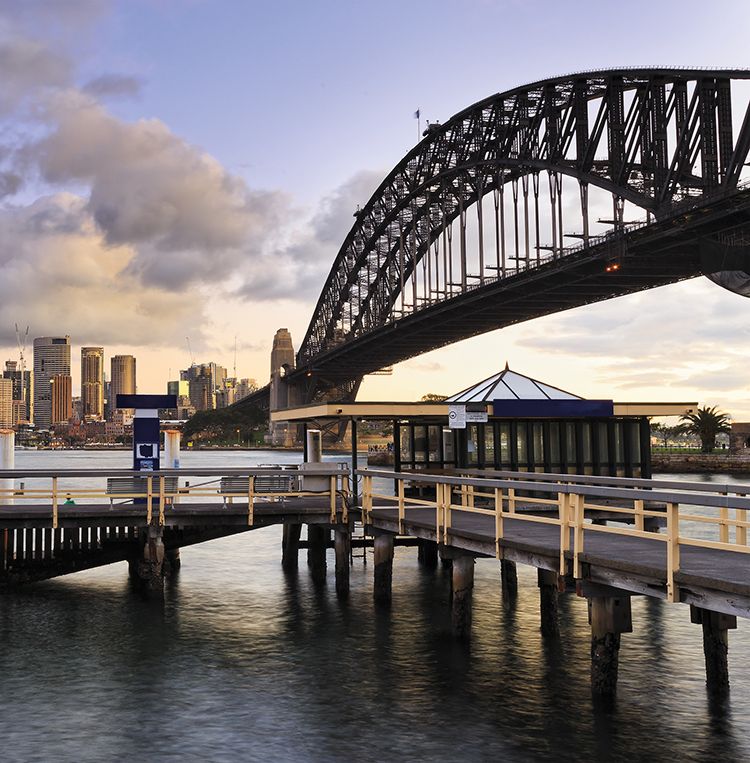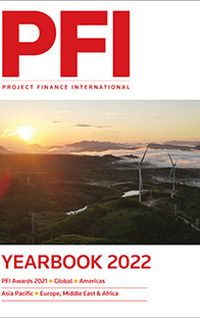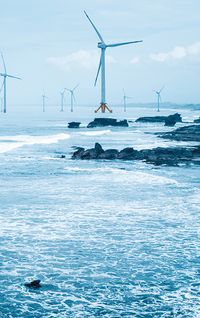Bank of the Year – HSBC
HSBC, one of the largest banking institutions, has remained active during the year and was at the forefront of activities in the energy and infrastructure markets in Asia-Pacific, concluding transactions as an arranger or as a financial adviser. The bank has completed about 25 deals in Asia-Pacific this year, making a massive break in renewable energy that took more than half of its volume. It has led many of the bond issues in the growing Indian dollar market.
Leading the long list is the 605MW Greater Changhua 1 (CHW01) offshore wind project of Orsted. HSBC acted as lead financial adviser to the Danish developer on the sale of its 50% stake in CHW01 and stapled financing for a total transaction value of US$2.7bn.
In a structure that is a first for Taiwan, Orsted raised corporate financing for its share in the project and the new partners – Caisse de depot et placement du Quebec (CDPQ) and Taiwanese private equity fund Cathay PE – raised project financing via a holdco company. It attracted 15 banks and two insurance companies with five export credit agencies providing political risk cover. The financing is the largest M&A transaction in the region.
Another first that was introduced by HSBC was the financing for the Satria satellite PPP project of Indonesia. The bank was the financial adviser and mandated lead arranger and ECA coordinator for the 12-year US$431m loan for project company Satelit Nusantara Tiga (SNT). Revenues are in Indonesian rupiah and HSBC had to address concerns about foreign exchange risk, resulting in a structure that has both borrower and lenders sharing the risk. There is also an availability payment guarantee from Indonesia Infrastructure Guarantee Fund (IIGF).
The bank was played a major role in bond issuance, ranking third globally with 16 issues amounting to US$3.2bn. A significant portion were transactions in India that included issuers India Green Power, Azure Power and Renew Power as well as GMR’s Airports’ entities – Delhi International Airport and Hyderabad International Airport.
The bank was involved in other sectors such as transportation and telecoms infra as well as LNG projects. Examples are Summit Digitel Infrastructure in India and in Australia the A$11.1bn North East Link project, Royal Adelaide PPP, King of the Hills gold mine and many others, some of which were M&A deals and refinancing facilities that kept HSBC’s teams busy.
The bank is currently involved in the study of an energy transition mechanism (ETM) with the Asian Development Bank as countries and institutions move away from fossil fuel.
HSBC has two main teams in Asia-Pacific that cover the region. One is headed by Gregoire Bouzereau, who is based in Hong Kong and is managing director and Asia head of infrastructure finance, responsible for the region excluding Australia. His counterpart in Australia is Sydney-based Patrick Prange. Reporting to Bouzereau are Hong Kong-based Ji Yuan, who covers infrastructure and energy transactions , including renewables, in North Asia; Singapore-based Remi Degelcke, who covers South-East Asia; and Mumbai-based Khawar Iqbal, who takes care of Indian transactions that include both loans and bonds. In addition, the bank has Tony Scott, based in Hong Kong, as head of mining and metals in the region.
Deal of the Year – Greater Changhua 1
Many developers have been acquiring assets in this region with an aim to get a foothold in the growing renewable markets, including the active Taiwanese offshore wind market. Orsted of Denmark, which was awarded four sites in Changhua, has successfully attracted new partners – Caisse de depot et placement du Quebec (CDPQ, 47%) and Taiwanese private equity fund Cathay PE (3%) – to acquire a 50% stake in its 605MW Greater Changhua 1 project, also referred to as the Mercury project.
Orsted, on behalf of its new partners through a holdco project financing model, raised a multi-tranche 18-year US$2.68bn limited recourse financing to fund the development of the 605MW Greater Changhua 1 offshore wind farm. The Danish developer is constructing the wind farm under a full-scope EPC contract and will perform O&M services for 20 years.
The financing, the largest offshore wind M&A and non-recourse acquisition project financing transaction in the region, is a first in Taiwan and in the region, making it PFI’s Asia-Pacific deal of the year.
The loan package was signed early this year and achieved financial closing in November, after securing all required approvals for equity selldown.
The financing package, which was structured and led by Orsted with financial advisers CTBC and HSBC, was supported by five international ECAs, namely, Eksport Kredit Fonden (EKF) of Denmark, UK Export Finance (UKEF), Atradius of the Netherlands, Korea Trade Insurance Corporation (KSURE), and Export Development Canada (EDC), which is participating for the first time in an offshore wind farm deal in Taiwan.
The lenders’ group comprises local financial institutions – Cathay United Bank, CTBC Bank, E-Sun Bank, Taipei Fubon Bank, Cathay Life Insurance Co, and Taiwan Life Insurance; and international lenders – BNP Paribas, Credit Agricole, Deutsche Bank, DZ Bank, HSBC, Korea Development Bank, OCBC, Siemens Bank, Societe Generale, Standard Chartered and SMBC.
Sponsors’ legal adviser was Allen & Overy and lenders had Linklaters. The lenders also had Wood as technical adviser, ERM as E&S adviser, Marsh as insurance adviser and Mazars as model auditor.
Solar Deal of the Year – Cirata
Greenfield development of power projects in Indonesia is relatively scarce these days as the government reviews its policies and power supply needs. It has historically relied heavily on coal, gas and hydropower to produce electricity, thus, the Cirata floating solar power plant is significant and will become a trailblazer for growth in the solar energy sector.
The 15-year US$114m project financing for the 145MW floating solar project at Cirata Reservoir in West Java, Indonesia is PFI’s Asia Pacific Solar deal of the year.
The project, estimated to cost about US$145m, is being developed by Pembangkitan Jawa Bali Masdar Solar Energi (PMSE), a joint venture between PJBI (51%), a wholly owned subsidiary of state-owned utility company PLN, and Masdar (49%) of Abu Dhabi, United Arab Emirates.
The deal marks the first investment from the United Arab Emirates in Indonesian renewables.
The sponsors are expected to pioneer significant growth in solar PV by demonstrating the technical and commercial feasibility of large-scale solar PV systems in the country. One completed , it will be the largest floating solar project in Indonesia, representing an important step towards achieving the renewable targets of the government – 23% of the energy mix from renewable energy by 2025 and at least 48% by 2030.
The sponsors entered into a 25-year PPA with PLN in early 2020 and construction commenced in H2 2021 with completion targeted for Q4 2022.
The project has been designated as a National Strategic Project by the Indonesian government, giving it priority status and recognition of its economic and social benefits to the nation.
The loan. achieved against the backdrop of the Covid-19 pandemic, was provided by three commercial banks – SMBC, Societe Generale and Standard Chartered, without export credit agency coverage. Synergy Consulting was financial adviser. Legal advisers were Allen & Overy for the lenders and Shearman & Sterling for the sponsors.
Telecom Deal of the Year – Satria-1
The importance of digital platforms could never have been more highlighted than during the Covid-19 pandemic. With lockdowns everywhere, communication tools have helped us stay sane as they provide the means to communicate with family, friends and colleagues; and still remain productive as work can continue.
The development of the US$545m Satellite of the Republic of Indonesia (Satria) broadband satellite PPP project has indeed never come at a better time. It is the first satellite PPP in the country, and despite the challenges faced by the sponsors that include lockdowns during the Covid-19 pandemic, they successfully raised a 12-year US$431m loan for project company Satelit Nusantara Tiga (SNT). It is PFI’s Asia-Pacific Telecom Deal of the year.
The PSN consortium, which comprises sponsors Pasifik Satelit Nusantara (PSN), Pintar Nusantara Sejhtera, Nusantara satelit Sejahtera, and Dian Semesta Sentosa, won the bid when an international tender was held. The project involves providing services to the VSAT operator that will extend the service to the end-users.
The Satria PPP was initiated by Indonesia’s Ministry of Communication and Information Technology (MCIT) to provide broadband internet services (including free WiFi access) to more than 149,400 unserved Public Service Points including schools, hospitals and local government locations in some of the most remote locations in Indonesia
The project revenues will be in the form of availability payments and the Indonesia Infrastructure Guarantee Fund (IIGF) is providing guarantees on the payment of the availability fees and a portion of the termination payment under the PPP agreement.
The lenders of the loan, which was signed on February 24 this year, are Asian Infrastructure Investment Bank (AIIB), Korea Development Bank, HSBC and Santander. BPI France Assurance Export is providing cover to the commercial banks. This is AIIB’s first private-sector financing in Indonesia and the first satellite financing by AIIB and KBD globally.
HSBC acted as financial adviser. Legal advisers were White & Case for the lenders and Milbank for the sponsors. Jones Day was legal counsel to MCIT with the procurement of the Satria satellite PPP project.
Transport Deal of the Year – North East Link
The A$11.1bn North East Link PPP is the largest PPP ever financed in Australia. The PPP package includes delivery of twin three-lane 6.5km tunnels under the Yarra River and residential areas. NEL is the so-called "missing link" in Melbourne’s freeway network.
The project sponsors, contractors and the state government of Victoria have devised an innovative model, akin to an alliance structure, to share construction risks. The incentivised target cost (ITC) structure has been implemented in a PPP for the first time and was crucial amid cost blowouts and disputes affecting other transport mega projects in Australia. It could be replicated on future mega transport PPPs.
The Spark consortium equity investors are Capella Capital on behalf of Lendlease, DIF, John Laing, Pacific Partnerships, GS Engineering & Construction and WeBuild. The D&C contractor consortium is WeBuild, China State Construction Engineering Corp, GS E&C and CPB Contractors. Ventia is O&M contractor.
The private sector raised about A$4.5bn–$5bn of debt and equity, while state and federal government funded the remainder of the A$11.1bn capital cost. Spark raised A$4.2bn of project finance debt, featuring institutions, domestic banks and international banks. The debt is split into a 9.25-year tranche, a fixed-interest 20-year portion and a 31-year piece. More than A$3.2bn of the debt has a tenor longer than 20 years, thus removing refinancing risk.
Bank lenders were Bank of China, CBA, DZ Bank, KEB Hana Bank, Kexim, KfW IPEX-Bank, Kookmin Bank, Korea Development Bank, Mizuho, Natixis, NatWest, Nonghyup Bank, Shinhan Bank, Standard Chartered, SMBC, SMTB, United Overseas Bank and Westpac. Institutional lenders are IFM Investors, Just Retirement, Manulife Insurance Corp, NH Investments & Securities, Nippon Life Insurance, Samsung Global Infrastructure Investment, Sun Life Assurance of Canada, Swiss Re, TD Asset Management, Vantage Infrastructure, BlackRock and Mirae Asset Management.
Allens advised Spark, Herbert Smith Freehills the lenders, and DLA Piper the D&C contractor. Pinsent Masons advised Ventia. Victoria’s advisers included EY, Clayton Utz, Smedley Technical & Strategic, GHD, PwC and Rothschild.
PPP Deal of the Year – Footscray Hospital
The Footscray Hospital PPP in Melbourne is the single largest health infrastructure investment in Victoria’s history, with a A$1.5bn spend by the state. The new hospital will have an initial capacity of 508 inpatient beds and 608 points of care, with space for expansion.
Procurement and financing coincided with the Covid-19 outbreak. Final bids were on hold for two months in 2020 as Victoria locked down. Victoria named Plenary Health as preferred bidder in October 2020 during another extended lockdown. Financial close was finally in March 2021, though the project has retained its 2025 opening date in line with the government’s requirement.
The financing package was not altered from final bids to financial close. Amid the pandemic, parties negotiated for novel scenarios, such as risk shares and claims in case of lockdowns, and additional airborne disease outbreak systems, and the right insurance was needed at a time when some insurers were retreating.
Plenary Group holds 70% of the equity and Japanese trading house Sojitz Corp joined to take a minority 30%. The debt size is A$1.77bn (U$1.36bn) with a tenor of seven years. For Sojitz, this is its second hospital PPP globally after the Ikitelli Hospital in Turkey that opened in early 2021.
The MLAs, underwriters, and bookrunners are Mizuho Bank, NAB and Westpac. Crédit Industriel et Commercial, Nippon Life and Norinchukin are additional MLAs. Syndication participants were Bank of China, Bank of Communications, Industrial and Commercial Bank of China, Intesa Sanpaolo, Nord/LB, Norinchukin Australia, Standard Chartered and Sumitomo Mitsui Trust Bank. Debt includes a tranche to be repaid by the state’s A$573m capital contribution at commissioning, and a base tranche that converts to a term loan after construction.
Clayton Utz was legal adviser to Plenary, White & Case advised the lenders, Allens advised Multiplex and Norton Rose Fulbright advised Honeywell. Victoria’s advisers included PwC, MinterEllison, Waterman AHW, Jacobs and Destravis.
ESG Deal of the Year – Tilt Renewables
The acquisition of Tilt Renewables’ Australian portfolio by Powering Australian Renewables (PowAR) followed a highly competitive auction process and featured a bespoke non-recourse debt solution. The debt both refinances five operational wind farms with 506MW of capacity and finances construction of a 396W greenfield wind farm. The deal was the largest renewables acquisition to-date in the Australian and New Zealand market.
PowAR raised A$1.23bn of debt, with tranches of three, five and seven years, underwritten by five banks in one of the biggest underwritings in Australian project finance. The syndication was successful, with nine banks joining. MLAs, underwriters and bookrunners were MUFG, NAB, CBA, SMBC and Societe Generale. MLAs were Bank of China, ANZ, DBS, DNZ, ING, Westpac, Mizuho Bank and Credit Agricole. ICBC was a lead arranger.
Tilt’s Australian assets make PowAR the largest wind and solar generator in Australia, with a 1.31GW operational portfolio plus Tilt’s 3.6GW development pipeline. PowAR is a joint venture of Australia’s sovereign wealth fund the Future Fund, state government-owned Queensland Investment Corp, and ASX-listed energy utility AGL. PowAR had teamed up with Mercury NZ during the auction to buy the ASX and NZX-listed developer Tilt Renewables for A$2.9bn. Mercury NZ bought all Tilt’s New Zealand assets at close for NZ$797m.
The Australian assets included the A$700m Rye Park Wind Farm, which was shovel ready and featured significant merchant exposure. PowAR structured a tranche of the A$1.23bn debt to fund Rye Park Wind’s construction under the same facility agreement, while ensuring that the M&A process would not delay the start of its construction. Rye Park will feature Vestas’ largest Enventus model turbines at 6MW capacity each, for their first deployment in Australia.
PowAR’s advisers were Bank of America, Jarden, Gilbert + Tobin, Herbert Smith Freehills, Jacobs, Baringa, Aon and PwC.
Indian Deal of the Year – Adani Transmission
Adani Transmission raised a US dollar loan to project-finance greenfield transmission projects for the first time in the Indian market. The loan will fund construction of four transmission projects in Gujarat and Maharashtra with a total cost of US$1.5bn.
The US$700m revolving loan facility’s structure allows staged drawdowns and repayments, facilitating constructions on differing timelines. The projects first three projects are due to be refinanced on the capital markets after completion, earlier than one project that has yet to start a four-year construction period. There are five different tranches, with tenors ranging from 4 to 5.75 years. Parties agreed a Platform Infrastructure Financing Framework of agreed principles and procedures under which Adani Transmission can engage with the financiers to raise up to US$1.1bn when fully drawn. The mandated lead arrangers and bookrunners were Standard Chartered, MUFG, DBS, SMBC, Intesa Sanpaolo, Mizuho, Siemens Bank and Societe Generale.
The Gujarat projects LBTL and WRSS will facilitate evacuation of renewable energy from wind and solar projects in Bhuj, Dwarka and Lakadia under the Green Energy Corridor-II scheme developed by the Ministry of Power. The two Maharashtra projects will improve transmission infrastructure serving the city of Mumbai and introduce new transmission HVDC technology to reduce transmission losses.
Lenders were able to get comfortable with the revenue streams through two different pooled mechanisms, which pool collection risk. One is managed by Central Electricity Regulatory Commission for the whole country transmission system, and the other was the pool managed by Maharashtra Electricity Regulatory Commission for the intra-state transmission system.
Adani Transmission is India’s largest private transmission company with a network of about 18,800 circuit kilometres, including 13,200ckt km in operations. Its target is to reach 20,000ckt km by 2022.
Latham & Watkins and Saraf & Partners advised Adani Transmission. Linklaters and Cyril Amarchand Mangaldas advised the lenders. Standard Chartered was documentation and account bank. MUFG was technical adviser.
To see the digital version of this report, please click here
To purchase printed copies or a PDF of this report, please email gloria.balbastro@lseg.com
















